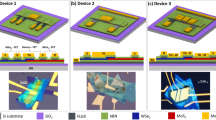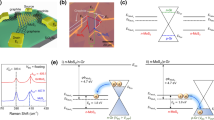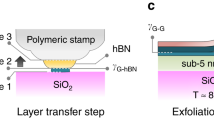Abstract
The most widespread method for the synthesis of 2D–2D heterostructures is the direct growth of one material on top of the other. Alternatively, flakes of different materials can be manually stacked on top of each other. Both methods typically involve stacking 2D layers through van der Waals forces—such that these materials are often referred to as van der Waals heterostructures—and are stacked one crystal or one device at a time. Here we describe the covalent grafting of 2H-MoS2 flakes onto graphene monolayers embedded in field-effect transistors. A bifunctional molecule featuring a maleimide and a diazonium functional group was used, known to connect to sulfide- and carbon-based materials, respectively. MoS2 flakes were exfoliated, functionalized by reaction with the maleimide moieties and then anchored to graphene by the diazonium groups. This approach enabled the simultaneous functionalization of several devices. The electronic properties of the resulting heterostructure are shown to be dominated by the MoS2–graphene interface.

This is a preview of subscription content, access via your institution
Access options
Access Nature and 54 other Nature Portfolio journals
Get Nature+, our best-value online-access subscription
$29.99 / 30 days
cancel any time
Subscribe to this journal
Receive 12 print issues and online access
$259.00 per year
only $21.58 per issue
Buy this article
- Purchase on Springer Link
- Instant access to full article PDF
Prices may be subject to local taxes which are calculated during checkout



Similar content being viewed by others
Data availability
The authors declare that all the data that support these findings are available in the manuscript and its Supplementary Information as well as from the corresponding authors on request. Source Data are provided with this paper.
References
Liu, Y. et al. Van der Waals heterostructures and devices. Nat Rev. Mater. 1, 16042 (2016).
Robinson, J. A. Growing vertical in the flatland. ACS Nano 10, 42–45 (2016).
Geim, A. K. & Grigorieva, I. V. Van der Waals heterostructures. Nature 499, 419–425 (2013).
Yankowitz, M., Ma, Q., Jarillo-Herrero, P. & LeRoy, B. J. Van der Waals heterostructures combining graphene and hexagonal boron nitride. Nat. Rev. Phys. 1, 112–125 (2019).
Neupane, G. P. et al. In-plane isotropic/anisotropic 2D van der Waals heterostructures for future devices. Small 15, e1804733 (2019).
Novoselov, K. S., Mishchenko, A., Carvalho, A. & Castro Neto, A. H. 2D materials and van der Waals heterostructures. Science 353, aac9439 (2016).
Jariwala, D., Marks, T. J. & Hersam, M. C. Mixed-dimensional van der Waals heterostructures. Nat. Mater. 16, 170–181 (2017).
Bertolazzi, S., Krasnozhon, D. & Kis, A. Nonvolatile memory cells based on MoS2/graphene heterostructures. ACS Nano 7, 3246–3252 (2013).
Ulstrup, S. et al. Ultrafast band structure control of a two-dimensional heterostructure. ACS Nano 10, 6315–6322 (2016).
Shi, Y. et al. Van der Waals epitaxy of MoS2 layers using graphene as growth templates. Nano Lett. 12, 2784–2791 (2012).
Yu, L. et al. Graphene/MoS2 hybrid technology for large-scale two-dimensional electronics. Nano Lett. 14, 3055–3063 (2014).
Lorchat, E. et al. Filtering the photoluminescence spectra of atomically thin semiconductors with graphene. Nat. Nanotechnol. 15, 283–288 (2020).
Cao, Y. et al. Unconventional superconductivity in magic-angle graphene superlattices. Nature 556, 43–50 (2018).
Kezilebieke, S. et al. Topological superconductivity in a van der Waals heterostructure. Nature 588, 424–428 (2020).
Zhang, L. et al. Van der Waals heterostructure polaritons with moiré-induced nonlinearity. Nature 591, 61–65 (2021).
Flöry, N. et al. Waveguide-integrated van der Waals heterostructure photodetector at telecom wavelengths with high speed and high responsivity. Nat. Nanotechnol. 15, 118–124 (2020).
Wang, X. et al. Realization of vertical metal semiconductor heterostructures via solution phase epitaxy. Nat. Commun. 9, 3611 (2018).
Le, C. T. et al. Effects of interlayer coupling and band offset on second harmonic generation in vertical MoS2/MoS2(1–x)Se2x structures. ACS Nano 14, 4366–4373 (2020).
Choi, W. et al. Optoelectronics of multijunction heterostructures of transition metal dichalcogenides. Nano Lett. 20, 1934–1943 (2020).
Li, C. et al. Engineering graphene and TMDs based van der Waals heterostructures for photovoltaic and photoelectrochemical solar energy conversion. Chem. Soc. Rev. 47, 4981–5037 (2018).
Duong, D. L., Yun, S. J. & Lee, Y. H. Van der Waals layered materials: opportunities and challenges. ACS Nano 11, 11803–11830 (2017).
Vera-Hidalgo, M., Giovanelli, E., Navio, C. & Perez, E. M. Mild covalent functionalization of transition metal dichalcogenides with maleimides: a “click” reaction for 2H-MoS2 and WS2. J. Am. Chem. Soc. 141, 3767–3771 (2019).
Quirós-Ovies, R. et al. Controlled covalent functionalization of 2H‐MoS2 with molecular or polymeric adlayers. Chem. Eur. J. 26, 6629–6634 (2020).
Vázquez Sulleiro, M. et al. Covalent cross-linking of 2H-MoS2 nanosheets. Chem. Eur. J. 27, 2993–2996 (2021).
Villalva, J. et al. Covalent modification of franckeite with maleimides: connecting molecules and van der Waals heterostructures. Nanoscale Horizons 6, 551–558 (2021).
Bahr, J. L. & Tour, J. M. Highly functionalized carbon nanotubes using in situ generated diazonium compounds. Chem. Mater. 13, 3823–3824 (2001).
Strano, M. S. et al. Electronic structure control of single-walled carbon nanotube functionalization. Science 301, 1519–1522 (2003).
Bahr, J. L. et al. Functionalization of carbon nanotubes by electrochemical reduction of aryl diazonium salts: a bucky paper electrode. J. Am. Chem. Soc. 123, 6536–6542 (2001).
Paulus, G. L., Wang, Q. H. & Strano, M. S. Covalent electron transfer chemistry of graphene with diazonium salts. Acc. Chem. Res. 46, 160–170 (2013).
Lomeda, J. R. et al. Diazonium functionalization of surfactant-wrapped chemically converted graphene sheets. J. Am. Chem. Soc. 130, 16201–16206 (2008).
Liu, Y., Zhao, Y., Jiao, L. & Chen, J. A graphene-like MoS2/graphene nanocomposite as a highperformance anode for lithium ion batteries. J. Mater. Chem. A 2, 13109–13115 (2014).
Yang, L. et al. Lattice strain effects on the optical properties of MoS2 nanosheets. Sci Rep. 4, 5649 (2014).
Mahouche-Chergui, S., Gam-Derouich, S., Mangeney, C. & Chehimi, M. M. Aryl diazonium salts: a new class of coupling agents for bonding polymers, biomacromolecules and nanoparticles to surfaces. Chem. Soc. Rev. 40, 4143–4166 (2011).
Boukerma, K., Chehimi, M. M., Pinson, J. & Blomfield, C. X-ray photoelectron spectroscopy evidence for the covalent bond between an iron surface and aryl groups attached by the electrochemical reduction of diazonium salts. Langmuir 19, 6333–6335 (2003).
Lomeda, J. R. et al. Diazonium functionalization of surfactant-wrapped chemically converted graphene sheets. J. Am. Chem. Soc. 130, 16201–16206 (2008).
Chu, X. S. et al. Direct covalent chemical functionalization of unmodified two-dimensional molybdenum disulfide. Chem. Mater. 30, 2112–2128 (2018).
Li, D. O., Chu, X. S. & Wang, Q. H. Reaction kinetics for the covalent functionalization of two-dimensional MoS2 by aryl diazonium salts. Langmuir 35, 5693–5701 (2019).
Benson, E. E. et al. Balancing the hydrogen evolution reaction, surface energetics, and stability of metallic MoS2 nanosheets via covalent functionalization. J. Am. Chem. Soc. 140, 441–450 (2018).
Chen, X. et al. Covalent bisfunctionalization of two-dimensional molybdenum disulfide. Angew. Chem. Int. Ed. 60, 13484–13492 (2021).
Fan, J.-H. et al. Resonance Raman scattering in bulk 2H-MX2 (M = Mo, W; X = S, Se) and monolayer MoS2. J. Appl. Phys. 115, 053527 (2014).
Knirsch, K. C. et al. Basal-plane functionalization of chemically exfoliated molybdenum disulfide by diazonium salts. ACS Nano 9, 6018–6030 (2015).
Mignuzzi, S. et al. Effect of disorder on Raman scattering of single-layer MoS2. Phys. Rev. B 91, 195411 (2015).
Assresahegn, B. D., Brousse, T. & Bélanger, D. Advances on the use of diazonium chemistry for functionalization of materials used in energy storage systems. Carbon 92, 362–381 (2015).
Bahr, J. L. & Tour, J. M. Highly functionalized carbon nanotubes using in situ generated diazonium compounds. Chem. Mater. 13, 3823–3824 (2001).
Wang, Y. et al. Photoelectrochemical immunosensing of tetrabromobisphenol A based on the enhanced effect of dodecahedral gold nanocrystals/MoS2 nanosheets. Sens. Actuators B 245, 205–212 (2017).
Ryu, S. et al. Atmospheric oxygen binding and hole doping in deformed graphene on a SiO2 substrate. Nano Lett. 10, 4944–4951 (2010).
Wang, Q. H. et al. Understanding and controlling the substrate effect on graphene electron-transfer chemistry via reactivity imprint lithography. Nat. Chem. 4, 724–732 (2012).
Fan, X. Y., Nouchi, R., Yin, L. C. & Tanigaki, K. Effects of electron-transfer chemical modification on the electrical characteristics of graphene. Nanotechnology 21, 475208 (2010).
Farmer, D. B. et al. Chemical doping and electron–hole conduction asymmetry in graphene devices. Nano Lett. 9, 388–392 (2009).
Sinitskii, A. et al. Kinetics of diazonium functionalization of chemically converted graphene nanoribbons. ACS Nano 4, 1949–1954 (2010).
Pham, T. et al. MoS2–graphene heterostructures as efficient organic compounds sensing 2D materials. Carbon 142, 504–512 (2019).
Zhang, W. et al. Ultrahigh-gain photodetectors based on atomically thin graphene–MoS2 heterostructures. Sci Rep. 4, 3826 (2014).
Ippolito, S. et al. Covalently interconnected transition metal dichalcogenide networks via defect engineering for high-performance electronic devices. Nat. Nanotechnol. 16, 592–598 (2021).
Gbadamasi, S. et al. Interface chemistry of two-dimensional heterostructures–fundamentals to applications. Chem. Soc. Rev. 50, 4684–4729 (2021).
Bottari, G., de la Torre, G., Guldi, D. M. & Torres, T. Covalent and noncovalent phthalocyanine−carbon nanostructure systems: synthesis, photoinduced electron transfer, and application to molecular photovoltaics. Chem. Rev. 110, 6768–6816 (2010).
Martín, N. et al. Electronic communication in tetrathiafulvalene (TTF)/C60 systems: toward molecular solar energy conversion materials? Acc. Chem. Res. 40, 1015–1024 (2007).
Villalva, J. et al. Spin-state-dependent electrical conductivity in single-walled carbon nanotubes encapsulating spin-crossover molecules. Nat. Commun. 12, 1578 (2021).
Acknowledgements
The authors acknowledge European Research Council (ERC-PoC- 842606 (E.M.P.); ERC-AdG-742684 (J. S.) and the MSCA program MSCA-IF-2019-892667 (N.M.S.), MINECO (CTQ2017-86060-P (E.M.P.) and CTQ2016-79419-R), Ministerio de Ciencia e Innovación (RTI2018-096075-A-C22 (E.B.), RYC2019-028429-I (E.B.)) the Comunidad de Madrid (MAD2D-CM S2013/ MIT-3007 (E.M.P.), Y2018/NMT-4783 (A.D.)) and the Programa de Atracción del Talento Investigador 2017-T1/IND-5562 (E.B.)). CzechNanoLab Research Infrastructure supported by MEYS CR (LM2018110) are gratefully acknowledged. IMDEA Nanociencia acknowledges support from the Severo Ochoa Programme for Centres of Excellence in R&D (MINECO, grant no. SEV-2016-0686). The funders had no role in study design, data collection and analysis, decision to publish or preparation of the manuscript.
Author information
Authors and Affiliations
Contributions
M.V.S., E.B. and E.M.P. conceived and designed experiments. M.V.S., R.Q.O. and M.V.H. synthesized compound 1. M.V.S. and R.Q.O. exfoliated and functionalized the materials. M.V.S., R.Q.O., N.M.S., M.L.G.J. and I.J.G. carried out the chemical and structural characterization. A.D., L.M.P. and E.B. fabricated the nanodevices and performed the electrical measurements. V.S., J. S., E.B. and E.M.P. supervised research and directed data analysis. M.V.S., E.B. and E.M.P. wrote the manuscript, with contributions from all authors.
Corresponding authors
Ethics declarations
Competing interests
The authors declare no competing interests.
Peer review
Peer review information
Nature Chemistry thanks the anonymous reviewers for their contribution to the peer review of this work.
Additional information
Publisher’s note Springer Nature remains neutral with regard to jurisdictional claims in published maps and institutional affiliations.
Supplementary information
Supplementary Information
Supplementary Figs. 1–35 and Tables 1–2.
Supplementary Data 1
Statistical source data for Supplementary Fig. 2.
Supplementary Data 2
Statistical source data for Supplementary Fig. 5.
Supplementary Data 3
Statistical source data for Supplementary Fig. 25.
Supplementary Data 4
Statistical source data for Supplementary Fig. 27.
Supplementary Data 5
Statistical source data for Supplementary Fig. 30a.
Source data
Source Data Fig. 2
Statistical source data for Fig. 2a.
Rights and permissions
About this article
Cite this article
Vázquez Sulleiro, M., Develioglu, A., Quirós-Ovies, R. et al. Fabrication of devices featuring covalently linked MoS2–graphene heterostructures. Nat. Chem. 14, 695–700 (2022). https://doi.org/10.1038/s41557-022-00924-1
Received:
Accepted:
Published:
Issue Date:
DOI: https://doi.org/10.1038/s41557-022-00924-1



